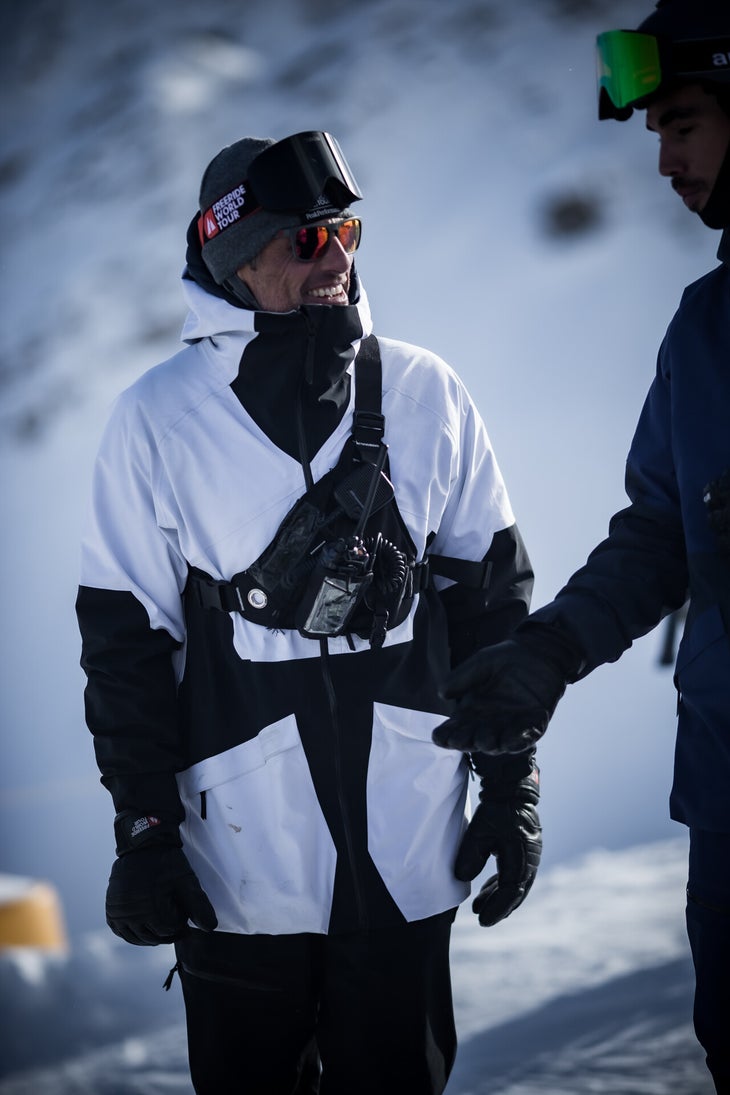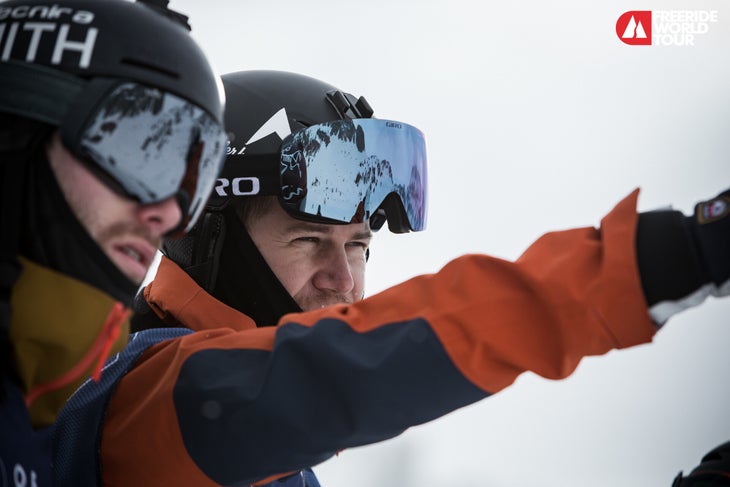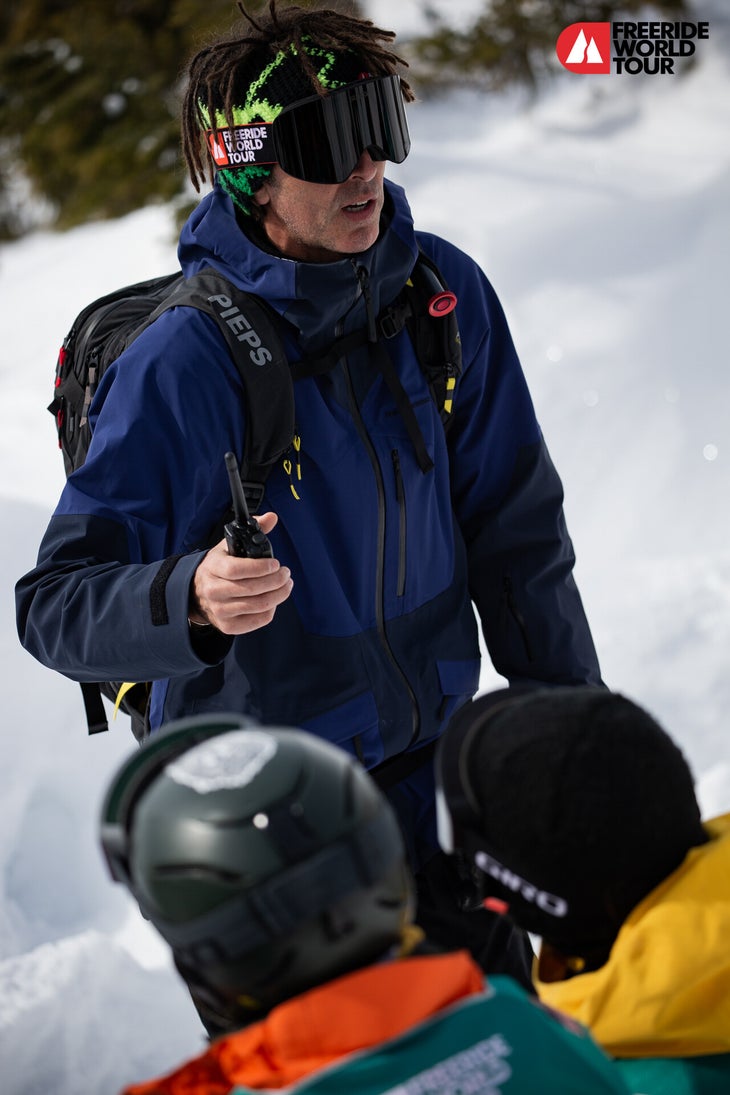Heading out the door? Read this article on the new Outside+ app available now on iOS devices for members! Download the app.
I serve on the Pro Freeriders Board. Ever heard of us? Its OK if you haven’t. Part of being a life-long devotee to competitive freeskiing—and the Freeride World Tour in particular—is realizing the degree to which our sport occupies a niche space in the mainstream skier’s consciousness. So I wouldn’t expect you to know about a little group of volunteers hidden within the organization of the FWT.
But some of the best conversations I’ve ever had about skiing have taken place in random hotel conference rooms around the world thanks to this group, so I want to tell you a little more about the PFB.
But first I have to rant briefly about Freeride remaining in relative anonymity in the mainstream ski consciousness. Take surfing as an example. I’m a Jerry-level practitioner of surfing but an expert fan. The format of professional surf competitions can be a little wonky to understand, but the sport itself is not. Surfers surf. There’s no course, no timing clock, just surfers and waves. There are different kinds of waves and different styles of surfers, but on any given day they paddle out and the best guy or gal wins. This is understood innately by experts and laypeople alike.
So when I’m called upon to explain the sport of freeride skiing to people unfamiliar with the competitions, I find myself at a loss. We’re all skiers who ski. There’s no set course, no clock, just skiers and mountains with snow on them. There are different kinds of mountains and different styles of skiers, but on any given day they go out and the best guy or gal wins.
It should already be clear—I think freeride is the most natural discipline of skiing there is. Start gate on top of a mountain with natural snow and terrain and a finish line at the bottom. I attribute (blame?) our having remained pigeonholed in this “core” niche—as some in the industry call it—to all the other contrived disciplines that have muddied the waters along the way. In other words, I blame Austrian alpine ski racers and Jesper Tjäder equally. I kid, I kid.
Watch Jesper in action: Over a River, Through the Woods
In all seriousness, there are lots of other kinds of skiing out there and—as a big-time fan of sliding on snow—I love pretty much all of them. The swerve kids (e.g. The Bunch) are blowing my mind on the daily, though I do wish Magnus would tighten/buckle his backpack straps. Mikaela Shiffrin is a once-a-generation talent, and her speed, reactions, nimbleness and consistency are unbelievable. X-Gamers and Dew Tour… Well, to be honest, I stopped counting around 1260 so I don’t care thaaaaat much, but I never miss a Harlaut run, and I wish the rest of those guys the best in their quest to make the ripe old age of 29 still able to walk. Casabon and Perron’s film Nuance gets my vote for best ski film in a generation (until T-Rice’s Dark Matter came out anyway).
And yeah, moguls exist still, somehow.
Anyway, even if it’s not perfect, it’s the closest we get. Freeride counts within its ranks of current and former competitors World Cup racers, Olympic freestylers, internationally-certified mountain guides, bump skiers, people who have never hiked, people who only hike, men, women, skiers, and snowboarders. There are Copenhagen-spitting Wyoming rednecks skiing with bisexual Frenchman with sequined cowboy hats. Honestly, we’ve got room for everyone.
Which brings us back to what I mentioned earlier, a little-known organization hiding within our sport, laboring behind the scenes to make sense out of this melting pot of all the different identities the sport brings together—the Pro Freeriders Board.
What is the Pro Freeriders Board?

The group was founded along with the launch of the Freeride World Tour back in 2008. According to the FWT rulebook, “The PFB was founded to ensure the best possible conditions for the growth of freeriding. It is made up of eight of the most prominent riders in the sport of freeride led by a General Secretary. Their task is to voice their opinions and wishes regarding season calendar, competition format, judging rules, a fair path for newcomers to qualify for the FWT through the FWQ and the ranking system. This approach ensures greater security and riders satisfaction.”
Thanks, rulebook.
Freeride World Tour CEO and visionary Nicolas Hale-Woods, along with his partner in the tour and former head judge Berti Denervaud, knew from the outset that the sport of freeride can never be static. Because it combines a lot of styles and riders, it needs to be allowed to continually evolve to reflect the most democratic and current version of the sport. Hence, the Pro Freeriders Board exists as the mechanism wherein individual riders’ input is incorporated into the rules, judging, and general direction of the sport.
Who is on the Pro Freeriders Board

I’ve been a member of the board for nearly ten years, and I think only Reine Barkered and Jackie Paaso outrank me in seniority. Now that Jackie has announced her retirement from the sport, however, it looks like Reine and I are locked in a battle for the longest-serving PFB member. I have a lot of admiration and respect for the other representatives as well, and the shared goal is to keep the balance of PFB members as diverse as possible with men, women, skiers, and snowboarders representing a variety of nationalities on the list.
The board currently has the following riders in its ranks, though some changes and additions will happen before 2021:
- Sammy Luebke (Snowboard, USA)
- Marion Haerty (Snowboard, FRA)
- Manuela Mandl (Snowboard, AUT)
- Reine Barkered (Ski, SWE)
- Léo Slemett (Ski, FRA)
- Tom Peiffer (Ski, CAN)
- Elisabeth Gerritzen (Ski, SUI)
Every member is a volunteer elected by our peers, and we’re there to serve.
The majority of our input happens virtually when we have conversations by emails and phone calls throughout the year. We also meet in-person a few times during the competitive season to discuss the finer points of changes to rules and judging by reviewing videos of runs and results that have given rise to differences in opinion.
What the PFB Does

Things get the most real for us when we’re in a situation where conditions for a competition present thin safety margins. It happens rarely, but there have been a handful of times when the day before—or even the morning of—a competition, Hale-Woods gathers the PFB group together on the mountain to meet with the head guide and/or judge. In these scenarios, we discuss if safety considerations require certain features be closed, or if the competition needs to be called off or relocated completely.
This played out dramatically in Andorra in 2019. A thin snowpack and warm temps had moved us to a “plan C” venue with the goal of holding the event on spring snow. The face was beautiful, if thinly-covered, and definitely held really good spring snow during at least part of the day. But there were a variety of concerns, the biggest of which was that through the three to four hours required to complete the competition, the snow wouldn’t be soft enough during the first half of the event, meaning should riders fall in a bad spot, consequential uncontrolled slides were likely.
With helicopters in the air, a live broadcast uplinking to a satellite, and hundreds of thousands of people around the world waiting for the event to “go,” to say there’s a little pressure is a big understatement. And though the PFB ultimately acts only in an advisory position in cases of safety like this (with the ultimate call coming from the FWT itself), Hale-Woods respected our opinion that it was a no-go, and we called off the day.
The result, in this case, was keeping the entire event on hold for an additional week until more snow arrived and moving to a different backup venue in winter conditions. And while it wasn’t the biggest or best face we’ve ever been on, we had a successful, safe competition.
Related: The Verbier Xtreme Meets its Match
For the FWT organizers, the tour is their passion, but it’s also their business. As for the PFB members, there’s no particular benefit or compensation to us. No money, meals, gifts, or privileged information before it’s available to the rest of the riders. We occasionally vote on proposed rule changes to judging, points, and safety. But essentially, we’re there because we want to be part of the conversation.
And, for me, that’s exactly what the whole sport of freeride is: a conversation. It just takes place (hopefully) on a big, snowy alpine face instead of a conference room.
Covering all of the points from our meetings over the years would be impossible, but a few major themes and questions come up as I think back. Reflecting on these now, these aren’t questions we settled. They stuck with me precisely because they remained unanswered.
I probably had my own answers and strong feelings one way or another, but the PFB didn’t reach consensus. But the freedom of expression is what attracts me to skiing and I would rather be in that room of diverse people and opinions than somewhere everyone looks and thinks alike. So I’ll leave you with a selection of these big questions, feel free to share your own answers (or even better, unsettled questions) below.
- Should airbag backpacks be required at all competitions regardless of conditions, and should riders be required to wear airbags during the entire official competition window (even if just “training” or “freeskiing” away from the official event)?
- How many, if any, additional points should judges award to an air which gaps over rocks, versus an air of the same or bigger size which doesn’t gap over any hazards? Similarly, if two different airs or features have the same size/technicality, but one is above significant dangerous exposure like cliff bands, should that feature score higher?
- What should score higher: Less interesting runs with zero control issues, or very exciting difficult runs with multiple control issues?
- If there is a sluff, pocket, or slab avalanche during a rider’s run, how should they be scored and should they receive the option of a re-run?
- Should men and women always compete on the same venue? Skiers and snowboarders too?
- Is competing on a slope that’s been skier-compacted—with bumps, traverses, etc.—a legitimate venue to hold a freeride competition on?
- Is it easier to go first, second, last, etc. in your field, and should such variation be accounted for in the judging?
- Should there be a difference in scoring between a run that takes a new line and gets fresh tracks compared to a run that gets tracked out by multiple riders?
- How important is the technicality of skiing between features compared to the airs themselves in the final judging? And how do you define and score this good technical riding?
- Should freeride events always be visual inspection-only, have some limited on-course inspection, or have a full day of on-course training and inspection before the competition itself?
SKI Magazine is an Official Media Partner for the Freeride World Tour. For more freeride action, catch up on the FWT20 season on SKI’s FWT Page.
